ISSN ONLINE(2319-8753)PRINT(2347-6710)
ISSN ONLINE(2319-8753)PRINT(2347-6710)
| Rakesh. R, Praveen. N, Prakash. E Department of Mechanical Engineering, Magna College of Engineering, Magaral, Chennai, India |
| Related article at Pubmed, Scholar Google |
Visit for more related articles at International Journal of Innovative Research in Science, Engineering and Technology
Cryogenics originated from two Greek words “kayos” which means “cold or freezing” and “genes” which means “born or produced”. Cryogenics is the study of very low temperatures or the production of the same. Liquefied gases like liquid nitrogen and liquid oxygen are used in many cryogenic applications. During World War II, when powerful rocket engines were first considered by the German, American and Soviet engineers independently, all discovered that rocket engines need high mass flow rate of both oxidizer and fuel to generate a sufficient thrust. Oxidizer is one of the most widely used. Both components are easily and cheaply available, And when burned have one of the highest entropy And when burned have one of the highest entropy Releases by combustion, producing specific Impulse up to 450 s, \(effective exhaust velocity 4.4 km/s).
INTRODUCTION |
| • Cryogenics originated from two Greek words “kayos” which means “cold or freezing” and “genes” which means “born or produced”. |
| • Cryogenics is the study of very low temperatures or the production of the same. Liquefied gases like liquid nitrogen and liquid oxygen are used in many cryogenic applications. |
HISTORY OF CRYONENIC |
| • During World War II, when powerful rocket engines were first considered by the German, American and Soviet engineers independently, all discovered that rocket engines need high mass flow rate of both oxidizer and fuel to generate a sufficient thrust. |
| • At that time oxygen and low molecular weight hydrocarbons were used as oxidizer and fuel pair. At room temperature and pressure, both are in gaseous state. |
| • Hypothetically, if propellants had been stored as pressurized gases, the size and mass of fuel tanks themselves would severely decrease rocket efficiency. |
| • Therefore, to get the required mass flow rate, the only option was to cool the propellants down to cryogenic temperatures (below −150 °C, −238 °F), converting them to liquid form. Hence, all cryogenic rocket engines are also, by definition, either liquid-propellant rocket engines or hybrid rocket engines. |
EARLY DAYS: |
| Various cryogenic fuel-oxidizer combinations Various cryogenic fuel-oxidizer combinations Have been tried, but the combination of liquid. Hydrogen (LH2) fuel and the liquid oxygen (LOX) |
| Oxidizer is one of the most widely used. Both components are easily and cheaply available, And when burned have one of the highest entropy And when burned have one of the highest entropy Releases by combustion, producing specific Impulse up to 450 s, \(effective exhaust velocity 4.4 km/s). |
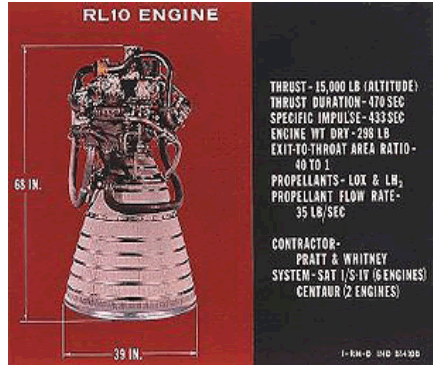 |
CRYOGENIC ENGINES |
| Cryogenic Engines are rocket motors designed for liquid fuels that have to be held at very low "cryogenic" temperatures to be liquid - they would otherwise be gas at normal temperatures. Typically Hydrogen and Oxygen are used which need to be held below 20°K (-423°F) and 90°K (-297°F) to remain liquid. |
| The engine components are also cooled so the fuel doesn't boil to a gas in the lines that feed the engine. The thrust comes from the rapid expansion from liquid to gas with the gas emerging from the motor at very high speed. The energy needed to heat the fuels comes from burning them, once they are gasses. Cryogenic engines are the highest performing rocket motors. One disadvantage is that the fuel tanks tend to be bulky and require heavy insulation to store the propellant. Their high fuel efficiency, however, outweighs this disadvantage. |
| The Space Shuttle's main engines used for liftoff are cryogenic engines. The Shuttle's smaller thrusters for orbital maneuvering use non-cryogenic hypergolic fuels, which are compact and are stored at warm temperatures. Currently, only the United States, Russia, China, France, Japan and India have mastered cryogenic rocket technology. |
CONSTRUCTION |
| • The major components of a cryogenic rocket engine are the combustion chamber (thrust chamber), pyrotechnic ignite, fuel injector, fuel cryopumps, oxidizer cryopumps, gas turbine, cryo valves, regulators, the fuel tanks, and rocket engine nozzle. |
| • In terms of feeding propellants to combustion chamber, cryogenic rocket engines (or, generally, all liquidpropellant engines) work in either an expander cycle, a gas-generator cycle, a staged combustion cycle, or the simplest pressure-fed cycle. |
| • The cryopumps are always turbo pumps powered by a flow of fuel through gas turbines. Looking at this aspect, engines can be differentiated into a main flow or a bypass flow configuration. |
| • In the main flow design, all the pumped fuel is fed through the gas turbines, and in the end injected to the combustion chamber. In the bypass configuration, the fuel flow is split; the main part goes directly to the combustion chamber to generate thrust, while only a small amount of the fuel goes to the turbine. |
WORKING DIAGRAM |
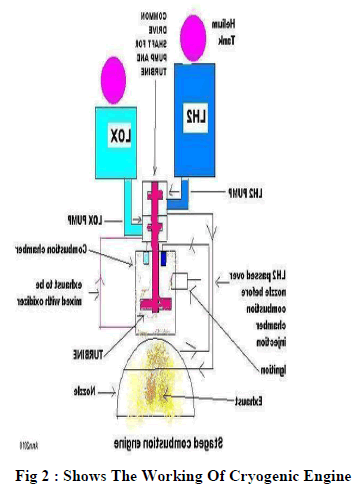 |
WORKING |
| âÞâ For using cryogenic propellants, special insulated containers and vents are used to prevent gas from the evaporating liquids to escape. |
| âÞâ The liquid fuel and oxidizer are fed from the storage tank to an expansion chamber. Then it is injected into the combustion chamber. |
| âÞâ In this chamber, they are mixed and ignited by a flame or spark. |
| âÞâ The fuel expands as it burns and the hot exhaust gases are directed out of the nozzle to provide thrust. |
ROCKET ENGINE POWER CYCLES |
| Gas pressure feed system :- |
| âÞâ A simple pressurized feed system is shown schematically below. It consists of a high-pressure gas tank, a gas starting valve, a pressure regulator, propellant tanks, propellant valves, and feed lines. |
| âÞâ Additional components, such as filling and draining provisions, check valves, filters, flexible elastic bladders for separating the liquid from the pressurizing gas, and pressure sensors or gauges, are also often incorporated. |
| âÞâ After all tanks are filled, the high-pressure gas valve is remotely actuated and admits gas through the pressure regulator at a constant pressure to the propellant tanks. |
| âÞâ The check valves prevent mixing of the oxidizer with the fuel when the unit is not in an right position. |
COMBUSTION IN THRUST CHAMBER |
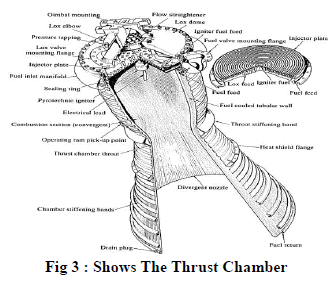 |
| The four phases of combustion in the thrust chamber are – |
| âÞâ Primary Ignition |
| âÞâ Flame Propagation |
| âÞâ Flame Lift off |
| âÞâ Flame Anchorin |
| Primary Ignition : |
| âÞâ begins at the time of deposition of the energy into the shear layer and ends when the flame front has reached the outer limit of the shear layer |
| âÞâ starts interaction with the recirculation zone. |
| âÞâ phase typically lasts about half a millisecond |
| âÞâ it is characterised by a slight but distinct downstream movement of the flame |
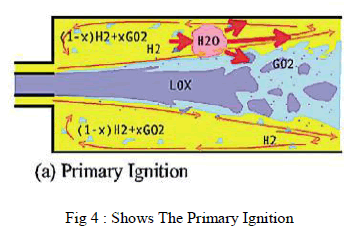 |
Flame Propagation |
| âÞâ This phase corresponds to the time span for the flame reaching the edge of the shear layer, expands into in the recirculation zone and propagates until it has consumed all the premixed propellants. |
| âÞâ This period lasts between 0.1 and 2 ms. |
| âÞâ It is characterised by an upstream movement of the upstream flame front until it reaches a minimum distance from the injector face plate. |
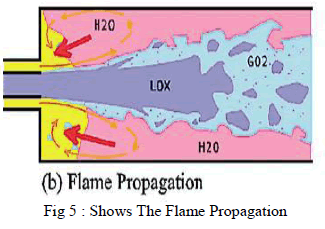 |
Flame Lift Off |
| âÞâ phase starts when the upstream flame front begins to move downstream away from the injector because all premixed propellants in the recirculation zone have been consumed until it reaches a maximum distance. |
| âÞâ This period lasts between 1 and 5 ms. |
| The emission of the flame is less intense showing that the chemical activity has decreased. |
| The position where the movement of the upstream flame front comes to an end, the characteristic times of convection the characteristic times of convection. |
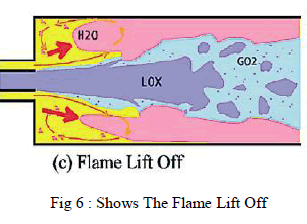 |
Flame Anchoring: |
| This period lasts from 20 Ms to more than 50 Ms, depending on the injection condition. |
| âÞâ It begins when the flame starts to move a second time upstream to injector face plate and ends when the flame has reached stationary conditions. |
| âÞâ During this phase the flame propagates upstream only in the shear layer. |
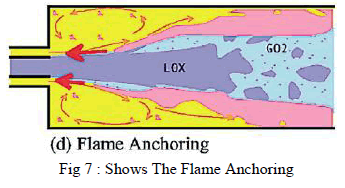 |
ADVANTAGES |
| 1. High Energy per unit mass: |
| Propellants like oxygen and hydrogen in liquid form give very high amounts of energy per unit mass due to which the amount of fuel to be carried aboard the rockets decreases. |
| 2. Clean Fuels |
| Hydrogen and oxygen are extremely clean fuels. When they combine, they give out only water. This water is thrown out of the nozzle in form of very hot vapour. Thus the rocket is nothing but a high burning steam engine |
| 3. Economical |
| Use of oxygen and hydrogen as fuels is very economical, as liquid oxygen costs less than gasoline. |
CONCLUSION |
| âÞâ The area of Cryogenics in Cryogenic Rocket Engines is a vast one and it cannot be described in a few words. As the world progress new developments are being made more and more new developments are being made in the field of Rocket Engineering. |
| âÞâ Now a day cryo propelled rocket engines are having a great demand in the field of space exploration. |
| âÞâ Due to the high specific impulse obtained during the ignition of fuels they are of much demand. |
References |
|